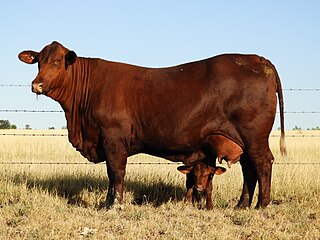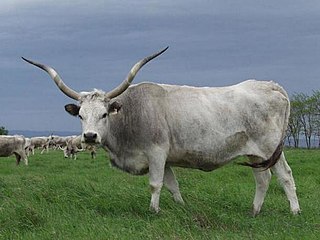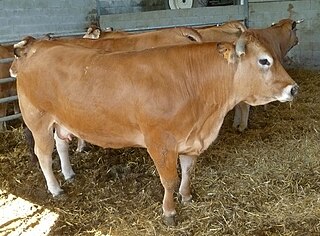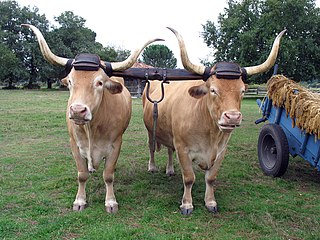
The Belgian Blue is a breed of beef cattle from Belgium. It may also be known as the Race de la Moyenne et Haute Belgique, or dikbil. Alternative names for this breed include Belgian Blue-White; Belgian White and Blue Pied; Belgian White Blue; Blue; and Blue Belgian. The Belgian Blue's extremely lean, hyper-sculpted, ultra-muscular physique is termed "double-muscling". The double-muscling phenotype is a heritable condition resulting in an increased number of muscle fibres (hyperplasia), instead of the (normal) enlargement of individual muscle fibres (hypertrophy).

The Charolais or Charolaise is a French breed of taurine beef cattle. It originates in, and is named for, the Charolais area surrounding Charolles, in the Saône-et-Loire department, in the Bourgogne-Franche-Comté region of eastern France.

The Galloway is a Scottish breed of beef cattle, named after the Galloway region of Scotland, where it originated during the seventeenth century.

The Guernsey is a breed of dairy cattle from the island of Guernsey in the Channel Islands. It is fawn or red and white in colour, and is hardy and docile. Its milk is rich in flavour, high in fat and protein, and has a golden-yellow tinge due to its high β-carotene content. The Guernsey is one of three Channel Island cattle breeds; the other two are the Alderney, which is now extinct, and the Jersey.

The Murray Grey is an Australian breed of polled beef cattle. It originated between 1905 and 1917 in the upper Murray River valley, on the border between New South Wales and Victoria. It is similar in appearance to the Aberdeen Angus, from which it largely derives, but is grey, silver or dun in colour.

The Corriente is an American breed of small cattle, used principally for rodeo events. It derives from Criollo Mexicano stock, which in turn descends from Iberian cattle brought to the Americas by the Conquistadores, and introduced in the sixteenth and seventeenth centuries to various parts of what is now Mexico.

The Belted Galloway is a traditional Scottish breed of beef cattle. It derives from the Galloway stock of the Galloway region of south-western Scotland, and was established as a separate breed in 1921. It is adapted to living on the poor upland pastures and windswept moorlands of the region. The exact origin of the breed is unclear, although the white belt for which they are named, and which distinguishes the breed from black Galloway cattle, is often surmised to be the result of cross-breeding with the similarly-coloured Dutch Lakenvelder.

The Santa Gertrudis is an American breed of beef cattle. It is a taurine-indicine hybrid breed, descended from both zebu and European cattle. It was bred in the early twentieth century in Texas, and received official recognition in 1940. It has been exported to many countries including Australia, Brazil and South Africa, and has contributed to the development of a number of modern breeds, among them the Barzona and the Droughtmaster.

The Blonde d'Aquitaine is a modern French breed of large domestic beef cattle. It was created in 1962 by merging three blonde draught breeds of south-western France, the Blonde des Pyrénées, the Blonde de Quercy and the Garonnaise. Since about 1970, it has been selectively bred specifically for beef production. It is the third-most numerous beef breed of France, after the Charolais and the Limousin. It has been exported to many countries round the world.

The Aubrac or Laguiole is a French breed of beef cattle. It originates on the Plateau de l'Aubrac in the Massif Central in central southern France, from which it also takes its name. It has a wheat-coloured coat and dark hooves, switch, muzzle and eyes.

The Hungarian Grey, also known as the Hungarian Grey Steppe, is a Hungarian breed of beef cattle. It belongs to the group of Podolic cattle and is characterised by long lyre-shaped horns and a pale grey coat. It is well adapted to extensive pasture systems and was formerly raised in very large numbers in the Hungarian puszta. In the twentieth century it came close to extinction, but numbers have since risen.

The Bazadaise or Grise de Bazas is a French breed of beef cattle. It takes its name from the town of Bazas in the département of the Gironde, in the Nouvelle-Aquitaine region of south-western France, and originates in the low-lying areas to the south of the River Garonne near that town. A festival, the Fête des Boeufs Gras, is held each year in Bazas to present fattened Bazadaise stock.

The Lourdaise is an endangered French breed of domestic cattle. It is named for the town of Lourdes, in the Hautes-Pyrénées département of the region of Occitanie, and originated in the surrounding country, particularly in the cantons of Argelès, Bagnères-de-Bigorre and Ossun. It was formerly a triple-purpose breed, kept for its milk, for its meat and for draught work. It was widely distributed in the Pyrénées of south-western France. It came close to extinction in the 1980s, but has since recovered following conservation efforts. It remains critically endangered.

Kalmyk cattle is a breed of beef cattle of the former Soviet Union, now found in the Russian Federation, in Kazakhstan and in Tajikistan. It is believed to have originated in Dzungaria, and to have been brought into south-eastern Russia by migrating Kalmyks in the seventeenth century.

The Armoricaine or Armorican is an endangered French breed of domestic cattle. It originated in Brittany in the nineteenth century. It has a red coat with white markings, and has short horns.

The Parthenaise is a French breed of beef cattle. It is named for the town of Parthenay in the département of Deux-Sèvres, in the Nouvelle-Aquitaine region of western France. It was formerly a triple-purpose breed, raised for milk, meat and draught work, but is now raised mainly for beef.

The Corse or Corsicana is a French breed of cattle indigenous to the island of Corsica.

The Pyrenean, French: Âne des Pyrénées, is a French breed of domestic donkey. It is distributed in a large area of south-western France, covering the whole of the regions of Aquitaine, Midi Pyrénées and Languedoc Roussillon. The largest concentration is in Aquitaine, which is a large part of the historic region of Gascony. The Pyrenean donkey breed unites two quite different types: the short and powerful Gascon type, and the taller and more elegant Catalan type, which is the French population of the Catalan donkey breed, approximately 20% of the total number of which is in the Roussillon.

The Béarnaise is a French breed of domestic beef cattle. It originates in the area of the traditional province of Béarn, in the east of the département of Pyrénées-Atlantiques, in the northern Pyrénées in south-west France. It was merged with other breeds in 1920 to form the Blonde des Pyrénées, which in turn was fused with the Blonde de Quercy and Garonnaise breeds to create the Blonde d'Aquitaine in 1962.

The Mirandaise is an endangered French breed of domestic cattle from the département of the Gers, in the historic region of Gascony, now part of the region of Occitanie in south-western France. It is named for the commune of Mirande, in the Gers. The Mirandaise is characterised by an unusual colouration of the areas around the anus and vulva, which are dark in the centre and pale towards the edges. This areola has given the breed its other name, the French: Gasconne aréolée. It is a different breed from the smaller Gasconne, which does not have the same colouration.




















